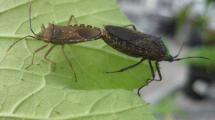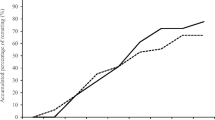Abstract
This study examined the effect of single, double, and triple matings on female lifetime fecundity in two closely related species of beetle, Callosobruchus analis and C. maculatus. Multiple mating resulted in elevated lifetime fecundities in both species, although the pattern of elevation differed between the two species. When oviposition resource was plentiful the elevation was apparent after a second but not a third copulation for C. maculatus and after a second and after a third for C. analis. By altering the availability of oviposition sites to C. maculatus females, we were able to alter the pattern of fecundity elevation between matings. When oviposition sites were limited, fecundity increased after a third mating but not a second mating. We suggest that the pattern of fecundity elevation associated with multiple mating in these species is primarily the result of oviposition stimulants delivered by males, rather than a nutritional “donation” brought about by the metabolism of ejaculates. We also suggest that the intra- and interspecific differences in the relationship between mating frequency and fecundity are the result of differences in egg maturation rates.
Similar content being viewed by others
REFERENCES
Baumann, H. (1974). Biological effects of paragonial substances PS1 and PS2 on females of Drosophila funebris. J. Insect Physiol. 20: 2347–2362.
Boggs, C. L. (1990). A general model of the role of male-donated nutrients in female insects' reproduction. Am. Nat. 136: 598–617.
Boucher, L., and Huignard, J. (1987). Transfer of male secretions from the spermatophore to the female insect in Caryedon serratus (OL.): Analysis of the possible trophic role of these secretions. J. Insect Physiol. 33: 949–957.
Cavalloro, R., and Delrio, G. (1971). Rilievi sul comportamento sessuale di Dacus oleae Gmelin (Diptera: Trypetidae) in laboratorio. Redia 52: 201–230.
Chapman, T., Liddle, L. F., Kalb, J. M., Wolfner, M. F., and Partridge, L. (1995). Cost of mating in Drosophila melanogaster females is mediated by male accessory gland products. Nature 373: 241–244.
Colegrave, N. (1993). Does larval competition affect fecundity independently of its effect on adult weight? Ecol. Entomol. 18: 275–277.
Credland, P. F., Dick, K. M., and Wright, A. W. (1986). Relationships between larval density, adult size and egg production in the cowpea seed beetle, Callosobruchus maculatus. Ecol. Entomol. 11: 41–50.
Eady, P. E. (1991). Sperm competition in Callosobruchus maculatus (Coleoptera: Bruchidae): A comparison of two methods used to estimate paternity. Ecol. Entomol. 16: 45–53.
Eberhard, W. G. (1996). Female Control: Sexual Selection by Cryptic Female Choice, Princeton University Press, Princeton, NJ.
Fox, C. W. (1993a). Multiple mating, lifetime fecundity and female mortality of the bruchid beetle, Callosobruchus maculatus (Coleoptera: Bruchidae). Funct. Ecol. 7: 203–208.
Fox, C. W. (1993b). The influence of maternal age and mating frequency on egg size and offspring performance in Callosobruchus maculatus (Coleoptera: Bruchidae). Oecologia 96: 139–146.
Fox, C. W., and Hickman, D. L. (1994). Influence of oviposition substrate on female receptivity to multiple mating in Callosobruchus maculatus (Coleoptera: Bruchidae). Ann. Entomol. Soc. Am. 87: 395–398.
Gwynne, D. T. (1984). Male mating effort, confidence of paternity and insect sperm competition. In Smith R. L. (ed.), Sperm Competition and the Evolution of Animal Mating Systems, Academic Press, London, pp. 117–149.
Huignard, J. (1970). Analyse expérimentale de certaines stimuli externes influençant l'ovogenèse chez Acanthoscelides obtectus Say (Coleoptera: Bruchidae). Collag. Int. Cent. Nat. Rech. Sci. (Fr.) 189: 357–380.
Huignard, J. (1983). Transfer and fate of male secretions deposited in the spermatophore of females of Acanthoscelides obtectus Say (Coleoptera: Bruchidae). J. Insect Physiol. 29: 55–63.
Igboekwe, A. D., and Adenuga, A. O. (1983). Studies on the bionomics of cocoa psyllid Tyora tessmanni (Aulmann). Rev. Zool. Africaine 97: 896–904.
Keller, L., and Reeve, H. K. (1995). Why do females mate with multiple males? The sexually selected sperm hypothesis. Adv. Study Behav. 24: 291–315.
LaMunyon, C. W. (1997). Increased fecundity, as a function of multiple mating, in an arctiid moth, Utetheisa ornatrix. Ecol. Entomol. 22: 69–73.
Leahy, M. G. (1967). Nonspecificity of the male factor enhancing egg-laying in Diptera. J. Insect Physiol. 13: 1283–1292.
Markow, T. A. (1985). A comparative investigation of the mating system of Drosophila hydei. Anim. Behav. 33: 775–781.
Mbata, G. N., Shu, S., and Ramaswamy, S. B. (1997). Rhythmicity of mating and oviposition in Callosobruchus subinnotatus (pic) (Coleoptera: Bruchidae). J. Insect Behav. 10: 409–423.
Ouedraogo, A. P. (1978). Étude de quelques aspects de la biologie de Callosobruchus maculatus F. (Coléoptère: Bruchidae) et de l'influence des facteurs externes stimulants (plante hôte et copulation) sur l'activité reproductice de la famelle, Thése Université Paul Sabatier, Thése 3eme Cycle.
Pickford, R., Ewen, A. B., and Gillott, M. (1969). Male accessory gland substance: An egg-laying stimulant in Melanoplus sanguipes (F.) (Orthoptera: Acrididae). Can. J. Zool. 47: 1199–1203.
Ridley, M. (1988). Mating frequency and fecundity in insects. Biol. Rev. 63: 509–549.
Sokal, R. R., and Rohlf, F. J. (1981). Biometry, 2nd ed., W. H. Freeman, San Francisco.
Southgate, B. J., and Howe, R. W. (1975). The specific status of Callosobruchus maculatus (F.) and Callosobruchus analis (F.). Bull. Entomol. Res. 48: 79–89.
Tamhankar, A. J. (1995). Host influence on mating behavior and spermatophore reception correlated with reproductive output and longevity of female Earias insulana (Boisduval) (Lepidoptera: Noctuidae). J. Insect Behav. 8: 499–511.
Turner, M. E., and Anderson, W. W. (1983). Multiple mating and female fitness in Drosophila pseudoobscura. Evolution 37: 714–723.
Utida, S. (1981). Polymorphism and phase dimorphism in Callosobruchus. In Laberyie, V. (ed.), The Ecology of Bruchida Attacking Legumes (Pulses), Dr. W. Junk, The Hague, pp. 143–147.
Watanabe, M. (1988). Multiple mating increases the fecundity of the yellow swallowtail butterfly, Papilio xuthus L., in summer generations. J. Insect Behav. 1: 17–29.
Wilson, K. (1989). The Evolution of Oviposition Behaviour in the Bruchid Callosobruchus maculatus, Ph.D. thesis, University of Sheffield, Sheffield.
Wilson, K., and Hill, L. (1989). Factors affecting egg maturation in the bean weevil Callosobruchus maculatus. Physiol. Entomol. 14: 115–126.
Zar, J. H. (1996). Biostatistical analysis, 3rd ed., Prentice Hall, Englewood Cliffs, NJ.
Zeh, J. A., and Zeh, D. W. (1994). Last-male sperm precedence breaks down when females mate with three males. Proc. Roy. Soc. Lond. B 257: 287–292.
Author information
Authors and Affiliations
Rights and permissions
About this article
Cite this article
Wilson, N., Tufton, T.J. & Eady, P.E. The Effect of Single, Double, and Triple Matings on the Lifetime Fecundity of Callosobruchus analis and Callosobruchus maculatus (Coleoptera: Bruchidae). Journal of Insect Behavior 12, 295–306 (1999). https://doi.org/10.1023/A:1020883220643
Issue Date:
DOI: https://doi.org/10.1023/A:1020883220643




